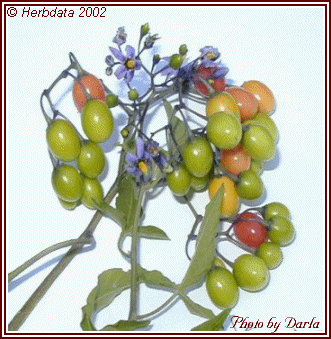

Dulcamara
USD 1926
Compiled and Edited by
Ivor Hughes
DULCAMARA.
N.F.
DULCAMARA
Dulcam.
[Bittersweet]
Dulcamara
is the dried stem of Solanum Dulcamara Linne (Fam.
Solanaceae).
Dulcamara contains not more than 2 per cent of foreign organic
matter." N. F.
Woody
Nightshade; Stipites Dulcamarae; Caulis
Dulcamarae; Tiges de Douceam�r,
(de Morello grimpante).
Douce am�rc, Fr.; Bittersűss,
Bittersűss-Stengel, Hindischkraut,
Alpranken, G.; Tallo
de Dulcamara.
Dulcamara
is a climbing shrub with a woody branching stem and purplish, cymose
flowers, with lemon-yellow anthers. The bright scarlet berries remain
after the falling of the leaves. The plant grows in wet places and
around dwellings and is common to
All
portions of the plant are active. Fatal results from the eating of the
berries by a child have been recorded. (P.
J., 1861.) For medicinal purposes the plant should be
gathered in the autumn after the fall of the leaf, and the extreme twigs
should be selected. That grown in high and dry situations is said to be
the best.
Description
and Physical Properties.
Unground
Dulcamara. In short sections about 5 mm. or less in
thickness, cylindraceous, outline of transverse section somewhat
angular, longitudinally striate, more or less warty; bark thin,
externally pale greenish, or light greenish brown, glabrous, marked with
alternate leaf scars, internally green, the greenish or yellowish wood
occurring in 1 to 2 concentric rings, usually hollow in the center. Odor
slight; taste bitter, afterwards sweet.
Structure.
- Epidermis with a rather thick outer cuticle; several rows of cork
composed of thin-walled cells and in the older stems entirely replacing
the epidermis; phellogen composed of a number of rows of tangentially
elongated cells; about six rows of collenchyma; a pericycle containing
non-lignified fibers which are mostly in an interrupted single row;
inner bark of parenchyma containing starch grains or sphenoidal
micro-crystals of calcium oxalate, or groups of sieve cells; a
continuous zone of cambium; a narrow zone of wood composed of numerous
tracheae, tracheids, wood fibers and lignified, porous parenchyma, the
latter forming medullary rays one cell in width; within the wood a
narrow zone of pith parenchyma with groups of sieve cells; pith
surrounding a central hollow.
Powdered
Dulcamara.
- Greenish yellow; exhibits tracheee up to
0.112 mm. in diameter and with bordered pores or with spiral markings;
tracheae-like cells having pointed ends, slightly lignified walls and
delicate spiral or reticulate markings; lignified wood fibers with few
pores; non-lignified bast-fibers with walls up to 0.015 mm. thick;
fragments composed of cork cells; very few, simple, unicellular hairs up
to 0.800 mm. long, and with the lumina usually distinct in the lower
portions only; starch grains, spheroidal, up to 0.012 mm. in diameter;
sphenoidal micro-crystals numerous, up to 0.007 mm. long." N.F.
The
dried twigs are inodorous, though the stalk in the recent state emits,
when bruised, a peculiar, rather nauseous odor. Their taste, which is at
first bitter and afterwards sweetish, have
given origin to the name of the plant.
The
picroglycion of Pfaff seems to be identical with dulcamarin. This was
obtained by Blitz, in the following manner: The aqueous extract was
treated with alcohol, the tincture evaporated, the residue dissolved in
water, the solution precipitated with lead sub acetate, the excess of
this salt decomposed by hydrogen sulphide, the liquor then evaporated to
dryness, and the residue treated with acetic ether, which yielded the
principle in small isolated crystals by spontaneous evaporation.
Uses.
In large doses dulcamara causes burning in the throat with nausea and
vomiting and dizziness; the pulse temporarily accelerated becomes slow,
the pupils dilated and there often occurs general weakness with
convulsive muscular movements.
Off.
Prep.
Fluidextractum Dulcamarae, N. F.
![]()